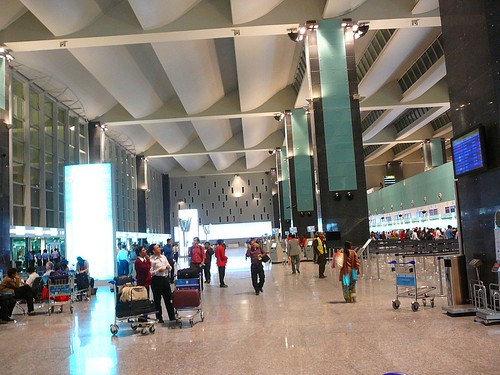Birthday Gift – India’s Bangalore Airport Gets the Central Government Nod for a High-Speed Rail Link to the City
(Source: The Hindu, Times of India)
Bengaluru International Airport records 8.7 million passengers as against 13 million projected for first year
The High Speed Rail Link (HSRL) to Bengaluru International Airport, which was on the drawing board for nearly two years, is set to see some action. The Centre has given the go-ahead to the project, along with committing some funds, and has asked the implementing authorities to hasten it. The new airport is 35 km away from the centre of this city and was conceived to handle the commercial airline traffic that is now handled by the 50-year-old HAL airport, which was bursting at its seams, handling 320 flights a day and 35,000-40,000 passengers daily or about 10 million passengers annually.
After several bureaucratic hitches, the Rs 5,767-crore project has gathered steam. The 34-km high-speed rail link will start from MG Road, run along the right side of National Highway up to BIA. The elevated train will go underground at BIA, below the airport lounge, which is 100 metres from check-in counters. It will take the underground route soon after the trumpet changeover for about 12 metres. The rail project requires 162-acre land on the highway. With the market bust, the compensation amount has been estimated at Rs 532 crore. The HSRL will start from BRV Grounds and have two stops — at Hebbal and Yelahanka.
The HSRL project went for a review in May, and the Centre gave its nod and agreed to take care of the Viability Gap Funding. The VGF pattern has been worked out on three parameters, in which the land acquisition cost is not taken into account. The project, which has already attracted 27 bidders for the Request For Qualification — will open the bids in August last week. The next step is technical bids.
While commencing commercial operations on May 24, 2008, promoters of Bengaluru International Airport Ltd. (BIAL) had forecast that it would handle 13 million passengers in the first year. Only 8.7 million passengers used the airport till May 23, 2009. The slump has been attributed to the economic slowdown.
A study conducted by BIAL has indicated that air passenger traffic will approximately touch nine million this year. The figure is likely to touch 14 million only by 2013-14. With the existing infrastructure, the airport can easily handle the passenger traffic for the next couple of years. BIA’s next expansion, expected to begin in early 2010, will include extending the apron from 42 aircraft parking stands to 62. Additionally, the existing terminal building will be expanded to accommodate the expected increase in passenger traffic. Seven new international airlines have commenced operations.
It is stated that BIAL would continue to realise its master plan and expand to accommodate increased traffic in terms of aircraft movement and passengers.
The new airport started its second year Sunday without any fanfare. Yet to be officially inaugurated or christened, the airport has got mixed reviews from passengers during the first year of its operations.
“The new airport is very far from the city. It takes a lot of time to commute because of heavy traffic. We lose precious time and that is not good for us,” Ved Pathak, a software professional, said. He was reflecting views expressed earlier by Biocon Chairperson Kiran Mazumdar Shaw and Infosys Director Mohandas Pai who had campaigned for retention of the old government-run Hindustan Aeronautics Ltd airport located within the city.
“The toilets at the new airport are cramped and not well maintained. We expect better facilities in an international airport,” remarked K. Vishwanathan, a marketing executive. But Sushmita, a student of business management, said: “It is definitely better compared to the old airport. The place is swanky with lots of eatouts. I quite like it.”
The airport made a wobbly takeoff May 24 last year, amid protests, legal battles and criticism over poor road connectivity. Today, it is a beehive of activity, with 280 aircraft landing or taking off per day and thousands of passengers arriving or departing. Though the $625-million (Rs.29,687-crore) greenfield airport took a decade to materialise, the first phase was completed in a record 36 months after construction began in mid-2005.
“After trials and tribulations of the first few months, we hope to see a change in our fortunes in the second year as we have accomplished a lot against heavy odds,” said a beaming Marcel Hungerbuehler, chief executive of Bangalore International Airport Ltd (BIAL), the consortium operating the airport.
However, the airport is yet to be officially inaugurated. While Prime Minister Manmohan Singh was to unveil the airport in March last year, the Karnataka assembly elections two months later May posed an obstacle, as the model code of conduct came into force.
About 30 airlines, including 20 international carriers, operate passenger and cargo services. Spread across 4,000 acres, the domestic terminal boasts of 53 check-in and 18 self check-in counters, three rapid exits and a taxiway system, 42 aircraft stands, eight passenger boarding bridges and two warehouses.
Built on the public-private partnership model, the airport’s consortium consists of Unique Zurich Airport, Siemens Projects Ventures and Larsen and Toubro (L&T) with a combined equity stake of 74%.
State government agencies and the country’s apex national airports operator, Airports Authority of India (AAI), hold the remaining 26%.

